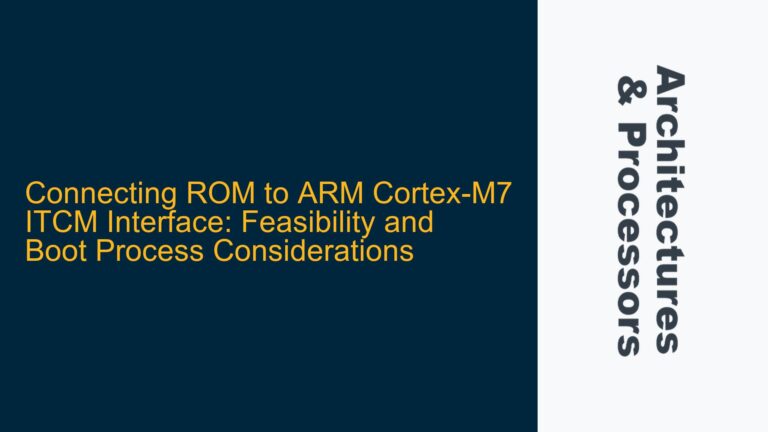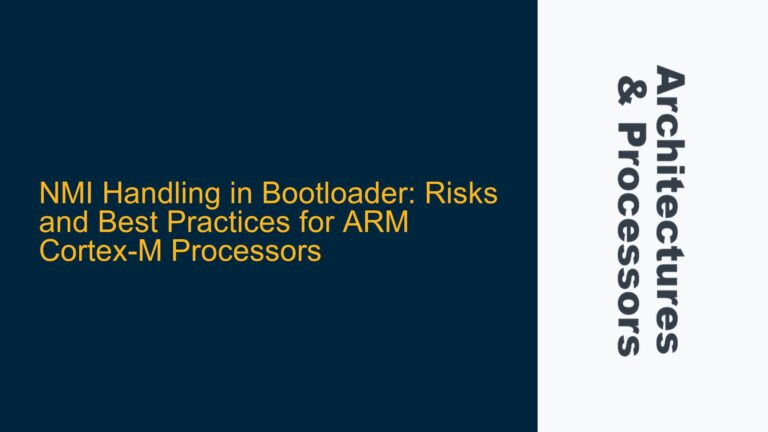SMMUv3 Integration and Testing Challenges in Armv8-A Base Platform FVP
The System Memory Management Unit version 3 (SMMUv3) is a critical component in modern ARM-based System-on-Chip (SoC) designs, enabling virtualization and secure memory management for peripheral devices. However, integrating and testing an SMMUv3 driver on the Armv8-A Base Platform Fixed Virtual Platform (FVP) presents several challenges, particularly due to the platform’s architecture and the dependencies on upstream components such as the PCIe subsystem.
The Armv8-A Base Platform FVP is a simulation model designed to emulate a generic ARMv8-A architecture, including components like CPUs, memory, and peripherals. The SMMUv3 in this platform is primarily connected to the PCIe subsystem, which complicates the testing of standalone SMMUv3 drivers. The lack of clear documentation regarding the SMMUv3’s integration and the absence of independent test engines further exacerbate the issue. This post delves into the specific challenges, their root causes, and actionable solutions for effectively testing SMMUv3 drivers on the Armv8-A Base Platform FVP.
PCIe Subsystem Dependency and Limited SMMUv3 Accessibility
The primary challenge in testing an SMMUv3 driver on the Armv8-A Base Platform FVP stems from the platform’s architecture, where the SMMUv3 is tightly coupled with the PCIe subsystem. The SMMUv3 instance in the FVP, identified as FVP_Base_RevC_2xAEMv8A.pci.pci_smmuv3.mmu, is designed to handle memory transactions from PCIe devices, specifically the VirtIO PCI block devices. This design choice means that the SMMUv3 cannot be tested independently without a functional PCIe subsystem.
The PCIe subsystem acts as the upstream component for the SMMUv3, meaning that all memory transactions routed through the SMMUv3 originate from PCIe devices. Consequently, testing the SMMUv3 driver requires a fully operational PCIe subsystem, including device enumeration, configuration, and transaction generation. This dependency creates a significant barrier for developers aiming to test SMMUv3 functionality in isolation, as it necessitates prior implementation and validation of PCIe support in the hypervisor or operating system.
Furthermore, the documentation for the Armv8-A Base Platform FVP does not provide detailed information about the StreamID assignments or the specific configuration of the SMMUv3 instance. StreamIDs are essential for identifying and routing transactions through the SMMUv3, and their absence in the documentation makes it difficult to configure and test the SMMUv3 driver effectively.
Upcoming Fast Models Release and SMMUv3 Test Engine
To address the challenges of testing SMMUv3 drivers on the Armv8-A Base Platform FVP, ARM has announced upcoming enhancements in the Fast Models release. These enhancements include the introduction of a test engine specifically designed for SMMUv3 models. The test engine, which ARM uses internally for validation, will be integrated into the Base FVP, enabling developers to drive memory transactions into the SMMUv3 without relying on the PCIe subsystem.
The test engine operates independently of the PCIe subsystem, providing a direct interface to the SMMUv3 for generating and monitoring memory transactions. This capability allows developers to test SMMUv3 functionality in isolation, bypassing the complexities of PCIe integration. The test engine is expected to support a wide range of SMMUv3 features, including translation, fault handling, and context management, making it an invaluable tool for driver development and validation.
In addition to the test engine, the upcoming Fast Models release will include updated documentation detailing the SMMUv3 configuration and StreamID assignments in the Armv8-A Base Platform FVP. This documentation will provide developers with the necessary information to configure the SMMUv3 instance and interpret its behavior during testing.
Implementing SMMUv3 Driver Testing with the Test Engine
With the introduction of the SMMUv3 test engine in the upcoming Fast Models release, developers can adopt a structured approach to testing SMMUv3 drivers on the Armv8-A Base Platform FVP. The following steps outline the process for leveraging the test engine effectively:
-
Environment Setup: Begin by updating to the latest version of the Fast Models release that includes the SMMUv3 test engine. Ensure that the Armv8-A Base Platform FVP is configured to include the SMMUv3 instance and the test engine. Verify that the simulation environment is correctly set up to support the test engine’s operation.
-
Configuration and Initialization: Use the updated documentation to configure the SMMUv3 instance, including StreamID assignments and translation table structures. Initialize the SMMUv3 driver in the hypervisor or operating system, ensuring that it correctly interfaces with the SMMUv3 hardware model.
-
Test Case Development: Develop a suite of test cases to validate the SMMUv3 driver’s functionality. These test cases should cover key features such as address translation, fault handling, and context management. Utilize the test engine to generate memory transactions that exercise these features, monitoring the SMMUv3’s behavior and the driver’s response.
-
Debugging and Validation: Analyze the results of the test cases to identify any discrepancies or failures. Use the test engine’s monitoring capabilities to trace memory transactions and diagnose issues. Iterate on the test cases and driver implementation until all features are validated and the SMMUv3 operates as expected.
-
Integration with PCIe Subsystem: Once the SMMUv3 driver is validated in isolation, proceed to integrate it with the PCIe subsystem. Use the VirtIO PCI block devices to generate real-world memory transactions and verify that the SMMUv3 correctly handles them. This step ensures that the driver operates correctly in the full system context.
By following these steps, developers can effectively test and validate SMMUv3 drivers on the Armv8-A Base Platform FVP, leveraging the upcoming Fast Models release and the SMMUv3 test engine to overcome the challenges posed by the platform’s architecture.
Conclusion
Testing SMMUv3 drivers on the Armv8-A Base Platform FVP presents significant challenges due to the platform’s architecture and the dependency on the PCIe subsystem. However, the upcoming Fast Models release, with its integrated SMMUv3 test engine, provides a powerful solution for overcoming these challenges. By adopting a structured approach to driver testing and leveraging the new tools and documentation, developers can ensure the robustness and reliability of their SMMUv3 implementations, paving the way for successful integration into ARM-based SoC designs.






